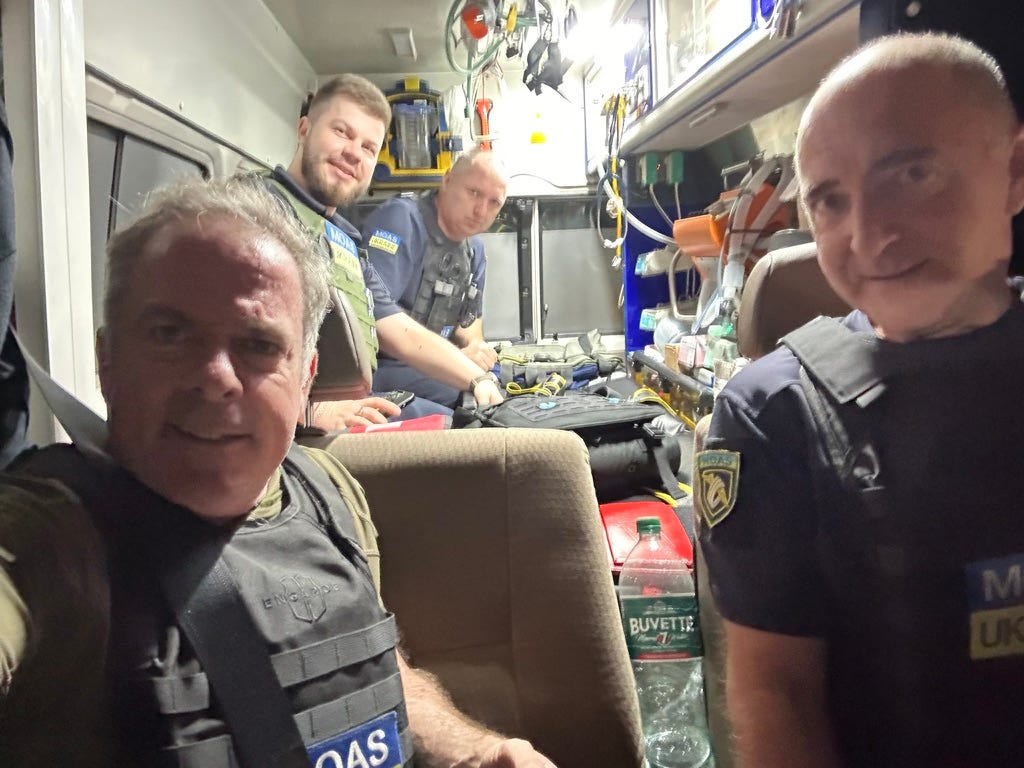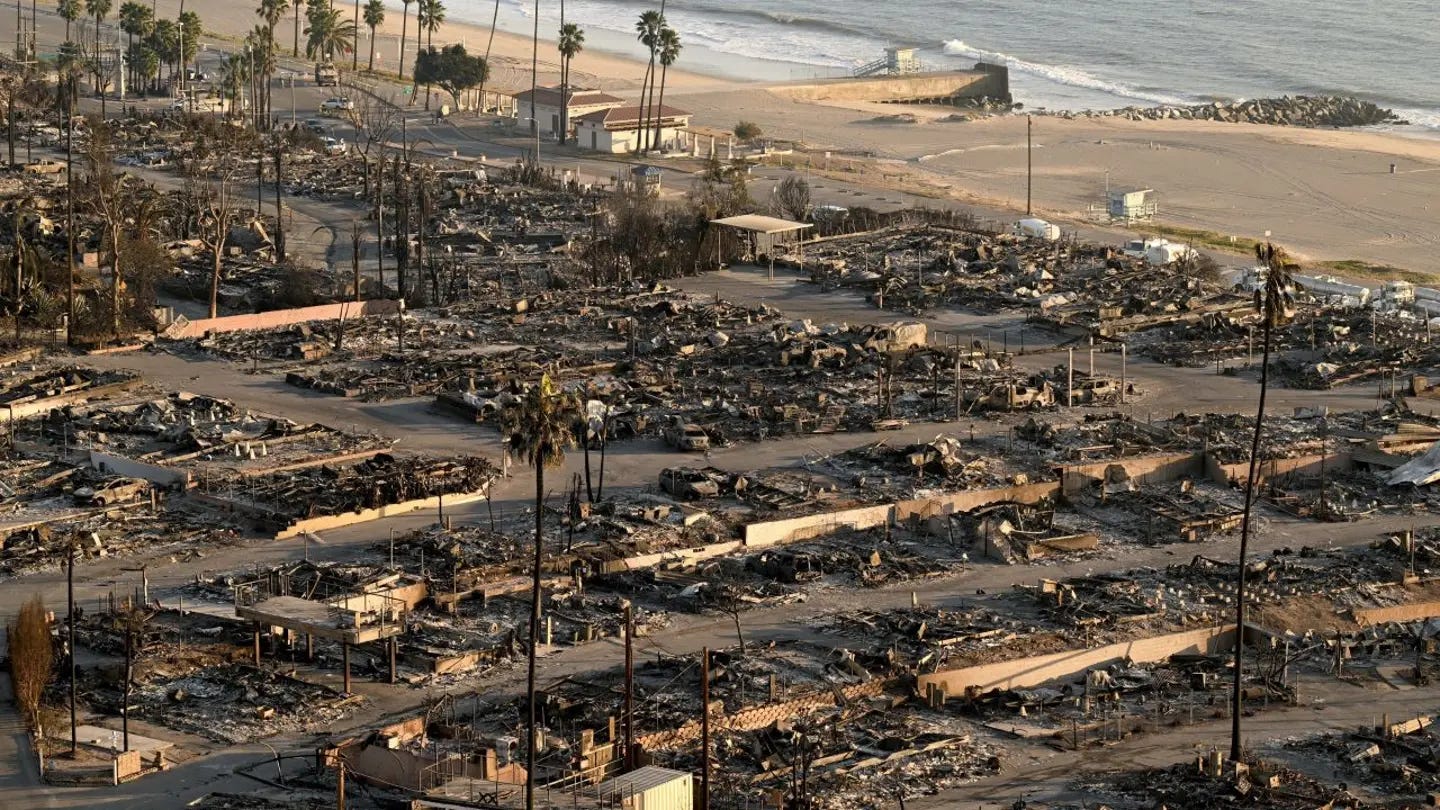Journalists are bad at math
117 million gallons of water should be sitting in the hills above Pacific Palisades, but it is not. Journalists are not asking the right questions about it. That's a lot like how they cover Ukraine.
Even while hearing Iranian drones fly by my apartment window, like most of the rest of the world, I have been drawn to the horrors of the fires that are consuming Los Angeles. The news media is falling short in similar ways in covering both Los Angeles and Ukraine.
The Santa Ynez reservoir served Pacific Palisades, a community of 24,000 now devastated by the wildfires. Despite 2023 being one of LA’s wettest years, the reservoir has been under repair and empty for at least a year.
NBC News interviewed Marty Adams, the recently retired General Manager and Chief Engineer of the Los Angeles Department of Water and Power, who presumably had some say in whether to close the reservoir and how long to close it.
Adams said “If Santa Ynez would have been in service, you probably would have had some help in keeping the pressures up. It wouldn’t have been a panacea. It probably would not have lasted forever.” He also told the Los Angeles Times “Would Santa Ynez [Reservoir] have helped? Yes, to some extent. Would it have saved the day? I don’t think so.”
To me that sounds a lot like NBC and the LA Times were interviewing the guy who likely screwed up by closing the Santa Ynez reservoir and/or not getting it reopened quickly enough, he was pretending that it wasn’t a big deal and both NBC and the LA Times took him at his word.
Both news outlets report that the Palisades area is served by three water storage tanks of a million gallons each, all of which quickly ran dry.
The Santa Ynez reservoir can hold 117 million gallons, or enough water to cover 4,308 acres - about 20% of the current area burned - with an inch of water. For my European friends, hat equals 17 square kilometers covered in 2.5cm of water,
It is hard to understand how 117 million gallons being available when three million gallons ran dry would not have "saved the day."
Adams claims that flows from the reservoir would have been constrained by a thirty-inch pipe. As it turns out, you can calculate the flow of a thirty-inch pipe online. A conservative estimate at a relatively slow velocity of 1 foot per second shows the reservoir would have yielded more than 3.3 million gallons of water the first day. That would have doubled the firefighter’s capacity when the flames needed to be put down.
Adams is technically correct - that water would not have lasted forever. At this slow pipe velocity, it would have lasted for “only” 35 days.
Five feet per second appears to be more standard. At this faster velocity, Pacific Palisades would have seen 16.7 million gallons per day for a week.
What does any of this have to do with Ukraine?
Journalists are scared of math. I know this firsthand. I was a journalism major primarily to avoid math classes. Later in life I got excited about math when I figured out you could use it to tell better stories.
These Santa Ynez calculations took me a couple of hours to figure out. They may not be precise, but it provides a basis for asking smart questions. It would have been interesting for these reporters to do a little math themselves then go back to Adams and ask him those questions, instead of printing his statement at face value.
In terms of Ukraine coverage, Tucker Carlson, is well-known for taking the Putin’s word at face value. He does the same for others who repeat the Kremlin line.
Carlson aside, the same outlets that are covering the Los Angeles fires typically report on a daily basis some variation of “Today something blew up in Ukraine” leading Americans to believe that Ukraine is a vast wasteland. I live in Kyiv and have had well-educated Americans ask me things like “Can you get food in Kyiv?” (spoiler alert - it is hard to get a bad meal in Kyiv)
A great example is the battle for Bakhmut. Most of the media coverage focused on the horrific destruction of the Russian-speaking Ukrainian city, but very few report the incredible number of Russians who died to take the city.
Case in point is this New York Times story: What’s Next for Russia After Spilling So Much Blood for Bakhmut?
With that headline, you’d think that this story reports the massive casualties the Ukrainians inflicted on the Russian at Bakhmut. But the discussion of casualties is limited to two sentences: Western estimates early this year put Russia’s casualties in wounded and dead at about 200,000 since its invasion, and Ukraine’s are thought to be similar. The fight for Bakhmut has since claimed thousands more casualties.
First off, Ukraine’s casualties are not thought to be similar. Thought by who? The Russians?
The Journal of Advanced Military Studies at Johns Hopkins points out that Ukraine sustained about 15-20% of the casualties they inflicted on the Russians at Bakhmut. More broadly, analysts think that the Russians have lost between two soldiers for every Ukrainian loss to six Russian soldiers for every Ukrainian casualty. This makes sense because for Ukraine to still be in the war, it can’t lose as many soldiers as Russia.
Ukraine has a strategy for maximum survivability for its soldiers. Well-trained medics. Mobile hospitals. Ambulances.

Russia just pours more meat into the war machine, as they have since the times of Peter the Great. We have talked to Ukrainian soldiers who have seen Russians coming at them armed with only shovels to dig trenches. If the soldiers with shovels retreat, they get shot by their Russian comrades. The Ukrainians can’t let them dig trenches for their better-armed comrades to shoot them from, so they shoot the soldiers with shovels. Killing unarmed soldiers takes its toll.
As I discussed in my column Russia’s Manpower Problem in Ukraine, Putin lost as many as 138,000 troops in taking Bakhmut, or about 14 casualties per yard in moving zero line from Bakhmut to Chasiv Yar.
In a similar loss in the US Revolutionary War, the American Colonial Army suffered about 40% of the casualties felt by the British at Bunker Hill. The British took the hill, but the American loss at Bunker Hill prompted the American Major General Nathanael Greene to say "I wish we could sell them another hill at the same price."
American media does not take this angle. They might if they weren’t so afraid of math. To be fair, maybe they don’t know history either.
More math. The Russians are in their sixth month of losing more soldiers than they did the month before, according to the UK Ministry of Defence. Nearly 50,000 Russian soldiers were killed or injured in December.
Rutgers professor of political science Alexander J. Motyl specializes in Ukraine and Russia. Calculating these trends out to their logical conclusion, he shows it will take the Russians 92 years to reach Kyiv at a cost of some 39 million soldiers.
American media is avoiding economics as well. You must turn to the Moscow Times to learn the Russian government has cut pensions to fund the war and interest rates are at an all-time high of 21%. The Moscow Times also reports that the the Russian government may be funding the war with corporate debt. Borrowing by Russian companies has increased 71% since mid-2022, an amount equal to almost 20% of GDP. A bank crisis against the backdrop of pension cuts would do a lot to make Putin stop spending money to kill Ukrainians.
This media aversion to math impacts public policy. Economist/YouGov polling shows that only 13% of Americans think Ukraine is winning, despite the math proving otherwise. Americans like supporting a winner, so support for the war would increase if the math were driving the reporting.
To be fair, only 21% of Americans think Russia is winning. The other 66% of Americans don’t know.
If only journalism majors had taken more math classes maybe they could better explain it.





Agree on all points and i wish it were not so.
What happened to fact-checking? What happened to checking their sources and as you say, doing their maths 🤷🏼♂️.
Better to quote direct; better, in some cases, the lie. Better the government or accepted narrative 🤦🏼♂️.
It's disappointing in the extreme.
Agreed. I often make the comment that people go into journalism because they like telling stories. Finding and framing a narrative; finding a vignette to illustrate it. They didn’t study math and economics, and in order to “avoid a mistake” it’s safer to just repeat what other people say. The framing of the Ukraine war and the non-analytic approach to reporting on it is just horrific.